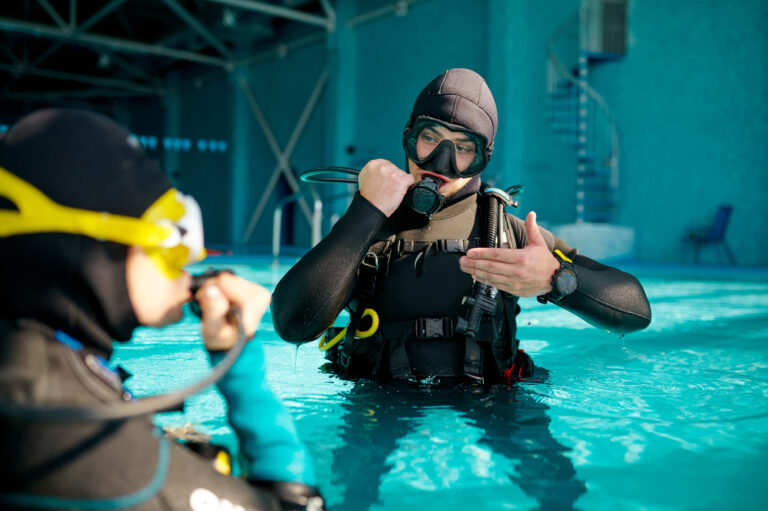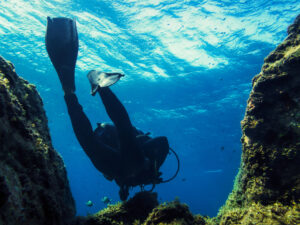What is a Quick Link?
A quick link, often used in scuba diving, is a small but crucial piece of hardware designed to connect various components of diving gear quickly and securely. Its design resembles a chain link but with a threaded closure, which allows for easy attachment and detachment. Quick links are indispensable in diving due to their strength, reliability, and ease of use, providing divers with a versatile tool for securing equipment such as hoses, accessories, and other essential items. Their simplicity and efficiency make them a preferred choice over other types of connectors.
History and Development of Quick Links
The concept of the quick link originated from the need for a reliable and secure method of connecting items in various industries, including construction and mountaineering. Initially, quick links were simple metal loops with a screw gate mechanism, designed to withstand heavy loads and harsh conditions. Over time, these links were adapted and refined for use in scuba diving, an industry that demands high standards of safety and reliability.
In the early days of scuba diving, divers often relied on carabiners and other types of connectors that were not specifically designed for underwater use. These connectors, while functional, had limitations in terms of corrosion resistance and ease of operation under water. The introduction of quick links to the diving community marked a significant advancement, providing a more durable and user-friendly solution. Manufacturers began to produce quick links specifically for diving, using materials like stainless steel and titanium to enhance corrosion resistance and strength.
As the popularity of scuba diving grew, so did the demand for specialized equipment. Quick links became a standard component of diving gear, widely recognized for their ability to secure various attachments efficiently. Today, they are an integral part of the diving industry, reflecting decades of innovation and improvement in design and functionality.
Design and Features
Quick links are characterized by their simple yet effective design. They typically consist of a solid metal loop with a screw gate that opens and closes to allow the attachment of other components. This screw gate mechanism is pivotal, providing a secure closure that can withstand significant forces, ensuring the link remains closed under pressure.
There are several variations in the design of quick links, tailored to different needs and preferences. The most common shapes include oval and D-shaped links, each offering unique advantages. Oval quick links provide a symmetrical shape that distributes weight evenly, making them ideal for general use. D-shaped quick links, on the other hand, direct the load along the straight spine, making them stronger and more suitable for higher loads.
Material choice is another crucial aspect of quick link design. Stainless steel is widely used due to its excellent resistance to corrosion and high strength-to-weight ratio. Titanium quick links, although more expensive, offer superior strength and even greater resistance to corrosion, making them ideal for use in saltwater environments. These materials ensure that quick links can endure the rigors of frequent exposure to water and harsh conditions without degrading.
The operational mechanism of quick links is designed for ease of use, even with gloved hands. The screw gate can be easily opened and closed, allowing divers to attach or detach equipment quickly. This feature is especially important in underwater environments where dexterity may be compromised. The reliability and straightforward operation of quick links make them an essential tool in the diver’s kit.
Functional Roles in Diving Equipment
Quick links play several vital roles in the setup and operation of diving equipment. One of their primary uses is in attaching accessories to the diver’s harness or BCD (Buoyancy Control Device). Items such as dive lights, slates, and cameras can be securely fastened using quick links, ensuring they are readily accessible during a dive.
In technical diving, quick links are often used to connect and secure various components of complex gear configurations. This includes attaching stage bottles, which are additional tanks carried by technical divers for extended range and deeper dives. Quick links provide a secure and reliable method to manage these additional tanks, allowing for easy attachment and detachment as needed.
Safety is a paramount concern in diving, and quick links contribute significantly to this aspect. They are commonly used as part of redundancy systems, ensuring that critical equipment remains attached even if primary attachment methods fail. For example, a quick link might be used to secure a regulator or an alternate air source, providing an additional layer of safety for the diver.
Quick links also facilitate the organization of diving gear. By providing a secure method to attach and manage various items, they help prevent entanglement and streamline the diver’s setup. This organization is crucial for both convenience and safety, reducing the risk of equipment becoming snagged or lost during a dive.
In rescue scenarios, quick links can be invaluable. They allow for the rapid assembly of emergency equipment, such as rescue lines and harnesses, ensuring a swift and effective response. Their ease of use and reliability make them a preferred choice in high-pressure situations where time and safety are critical.
Safety and Maintenance
Maintaining quick links in optimal condition is essential for ensuring their performance and safety. Regular inspection is crucial to identify any signs of wear or damage that could compromise their integrity. Divers should routinely check for corrosion, especially if the quick links are used in saltwater environments. Even stainless steel and titanium can show signs of corrosion over time, and early detection can prevent potential failures.
Common issues to look for include rust spots, pitting, and any deformities in the metal. The screw gate mechanism should also be tested regularly to ensure it operates smoothly. If the gate becomes difficult to open or close, it may indicate the need for cleaning or lubrication. Divers should use appropriate lubricants that are safe for underwater use and do not attract debris.
Best practices for maintaining quick links include rinsing them thoroughly with fresh water after each use, especially after diving in saltwater. This helps to remove salt deposits and other contaminants that can accelerate corrosion. Drying the quick links completely before storage is also important to prevent moisture-related damage.
Storage conditions play a significant role in the longevity of quick links. They should be stored in a dry, cool place, away from direct sunlight and extreme temperatures. Proper storage helps to prevent the buildup of moisture and reduces the risk of corrosion and material degradation.
In addition to routine maintenance, divers should follow manufacturer guidelines for the use and care of quick links. These guidelines often provide specific recommendations for cleaning, lubrication, and inspection, ensuring that the quick links remain in optimal condition for safe and reliable use.
Technical Specifications and Standards
The performance and safety of quick links in scuba diving are governed by various technical specifications and standards. These specifications ensure that quick links can withstand the demanding conditions of underwater use and provide reliable performance.
Load ratings are a critical specification for quick links, indicating the maximum force they can safely withstand. These ratings are typically provided in kilograms (and pounds) and are determined through rigorous testing. For example, a standard stainless steel quick link might have a load rating of 500 kg (1102 lbs), ensuring it can handle the stresses encountered during diving.
In addition to load ratings, quick links must comply with international diving safety standards. These standards are set by organizations such as the International Organization for Standardization (ISO) and the American National Standards Institute (ANSI). Compliance with these standards ensures that quick links meet stringent safety and performance criteria, providing divers with confidence in their equipment.
Material specifications are also important, particularly concerning corrosion resistance and strength. Stainless steel and titanium are the preferred materials due to their durability and resistance to the corrosive effects of seawater. These materials are tested for their ability to withstand long-term exposure to harsh environments without degrading.
Manufacturers often provide detailed technical data for their quick links, including dimensions, weight, and load ratings. This information helps divers select the appropriate quick links for their specific needs, ensuring compatibility and safety. It is essential for divers to consider these technical specifications when choosing quick links, as using an under-rated or incompatible link can lead to equipment failure and potential safety hazards.
Comparative Analysis with Other Fastening Devices
Quick links are not the only type of fastening device used in scuba diving; carabiners and snap hooks are also common alternatives. Each type of device has its unique features and advantages, making them suitable for different applications.
Carabiners, like quick links, are widely used in diving for attaching and securing equipment. They typically feature a spring-loaded gate that opens and closes quickly. While carabiners offer the advantage of rapid attachment and detachment, they can be less secure than quick links. The spring-loaded gate may accidentally open under pressure or if snagged, posing a potential risk in certain situations. However, locking carabiners, which feature an additional locking mechanism, provide enhanced security and are often used in critical applications.
Snap hooks are another alternative, characterized by a spring-loaded closure that snaps shut when released. They are commonly used for attaching accessories that need to be quickly accessed, such as dive slates or underwater cameras. Snap hooks offer convenience but may not provide the same level of security as quick links or locking carabiners, especially under heavy loads or in turbulent conditions.
Compared to carabiners and snap hooks, quick links offer a balance of security and ease of use. The screw gate mechanism provides a reliable closure that is less likely to open accidentally, while still allowing for quick and straightforward operation. This makes quick links particularly suitable for applications where both safety and convenience are paramount.
While each type of fastening device has its place in diving, quick links are often preferred for their robustness and reliability. Their design minimizes the risk of accidental opening, and their material composition ensures durability in harsh underwater environments. Divers must choose the appropriate fastening device based on their specific needs, considering factors such as load requirements, ease of use, and safety.
Key Takeaways
Quick links are an essential component of scuba diving equipment, offering a reliable and versatile method of securing various gear. Their design, characterized by a screw gate mechanism, provides a secure closure that can withstand significant forces. Quick links have evolved over time, becoming a standard tool in the diving industry due to their durability and ease of use. Regular maintenance and adherence to technical specifications ensure their continued performance and safety. While alternatives like carabiners and snap hooks have their uses
, quick links stand out for their balance of security and convenience, making them a preferred choice for divers worldwide.

















